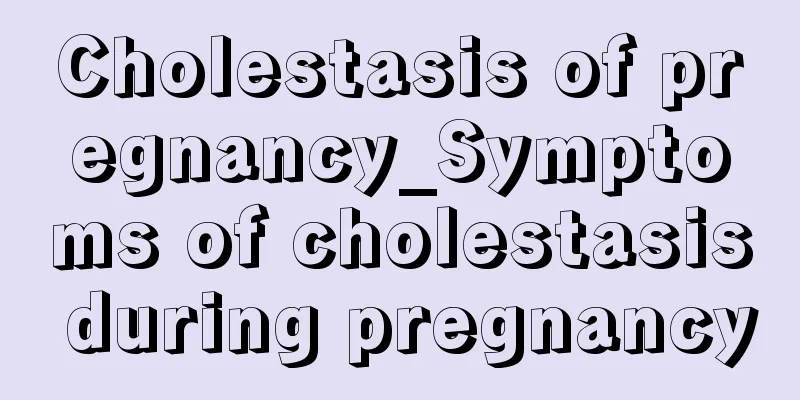Cholestasis of pregnancy_Symptoms of cholestasis during pregnancy

|
Cholestasis of pregnancy is a very common gynecological disease that has a great impact on the body of pregnant women. After a woman becomes pregnant, her body is more fragile and she is under greater pressure, so if she becomes ill it will have a great impact on the pregnant woman both physically and mentally. Therefore, if a woman suffers from cholestasis of pregnancy, she must seek timely treatment. So, what are the symptoms of cholestasis of pregnancy? Cholestasis of pregnancy What are the symptoms and signs of cholestasis of pregnancy? (1) What are the symptoms of cholestasis during pregnancy? In the second and third trimesters of pregnancy, itching first appears all over the body, which is more severe at night, and there is no specific rash. (2) There is no history of hepatitis or contact with the patient, and there are often no gastrointestinal symptoms or liver enlargement, and no percussion pain or tenderness. (3) Jaundice only occurs during pregnancy and disappears after the pregnancy ends. Pruritus occurs before jaundice appears. Jaundice is usually mild or moderate, much milder than itching. Diagnostic tests for cholestasis of pregnancy 1. Laboratory examination (1) Serum total bilirubin is elevated, reaching 68 to 88.5 μmol/L (4 to 5 mg/dL), but rarely exceeds 85.5 μmol/L. (2) Elevated serum bile acid levels, which can be 10 times higher than normal, are a specific sign of this disease. (3) Increased alkaline phosphatase activity. (4) Transaminase may be slightly or moderately elevated. Treatment options for cholestasis of pregnancy 1. Rest, include the patient in high-risk pregnancy management, conduct systematic monitoring, actively carry out symptomatic liver protection treatment and terminate the pregnancy when appropriate. 2. Drug treatment (1) Treatment with Chinese medicine that soothes the liver, stabilizes the fetus, and promotes bile secretion is effective. (2) Cholestyramine, 8-12 g/d, orally in 2-3 doses. (3) Phenobarbital 0.03 g, orally, 3/d. (4) Supplement vitamin C, vitamin B6 and vitamin K1 by adding them to glucose solution and dripping intravenously. Prevent intrapartum and postpartum hemorrhage. (5) Liver-protecting drugs, such as Gan Taile, etc. 3. Obstetric treatment/ (1) Strengthen monitoring and NST monitoring of the fetus at least once a week. (2) Induction of labor should be done after 37 weeks of pregnancy and in principle should not exceed the expected date of delivery. (3) If fetal heart rate abnormalities are detected or fetal distress is suspected during pregnancy or labor, cesarean section is often required to end the delivery. (4) Estrogen is contraindicated for inducing labor during pregnancy or for postpartum lactation. Nursing of cholestasis of pregnancy 1. After the onset of the disease, the pregnant woman is generally in good condition and has no obvious digestive system symptoms; 2. Itching is prominent and there is jaundice; 3. Liver function is only slightly impaired; 4. The condition does not worsen after delivery, and the symptoms and jaundice disappear quickly. Warm reminder: Cholestasis of pregnancy is very harmful to the fetus and can easily cause premature birth, low birth weight, fetal intrauterine distress and neonatal asphyxia. If pregnant women experience skin itching, they should get checked out promptly. The increase in serum conjugated bile acid before the onset of itching or the increase in serum alanine aminotransferase is a reliable indicator for early diagnosis. There is currently no specific drug treatment. Cholestyramine has a certain effect in relieving itching; ursodeoxycholic acid and dexamethasone also have certain therapeutic effects; phenobarbital can not only relieve itching, but also help to sleep peacefully at night. To prevent postpartum hemorrhage, vitamin K should be supplemented before delivery. If jaundice occurs or monitoring indicates possible fetal hypoxia, the patient should be hospitalized early and delivery should be ended promptly if necessary. The patient should also be alert to heavy bleeding after delivery. I wish you good health! |
<<: What is the reason for acne on the back
>>: Can I eat pears during confinement?
Recommend
There are many symptoms of cervical cancer in the vagina
There are many symptoms of cervical cancer in the...
How is the alcohol content calculated
Alcoholic beverages have a very high status in li...
The correct way to apply eye ointment to the nasal cavity
Ointments have many functions, and some ointments...
What is the white discharge from the corners of my eyes?
Eye health is extremely important for everyone, b...
What is the best medicine for glioma
Glioma is a brain tumor disease. Treatments inclu...
Methods to treat herpes, these are what you need to know
Herpes is a common skin disease, which is general...
How long does it take to cure viral facial paralysis
Viral facial paralysis will have adverse effects ...
How to use a face towel correctly?
As people's quality of life improves, more an...
What are blood diseases?
Blood is an important fluid in the human body. If...
Clothing combinations for girls with short hair
In the past two years, the Japanese style has bee...
What should I do if the soles of my feet hurt after standing for a long time?
Modern people are under great pressure in life an...
How many tonsils are there
Although we often hear about tonsillitis in our d...
How long does it take for double eyelid scars to disappear
For many girls who love beauty and pursue perfect...
What is the correct sitting posture
The correct sitting posture is to tuck your chin ...
How to take care of your hair after hair pulling
If your hair is not straight enough, you can use ...









